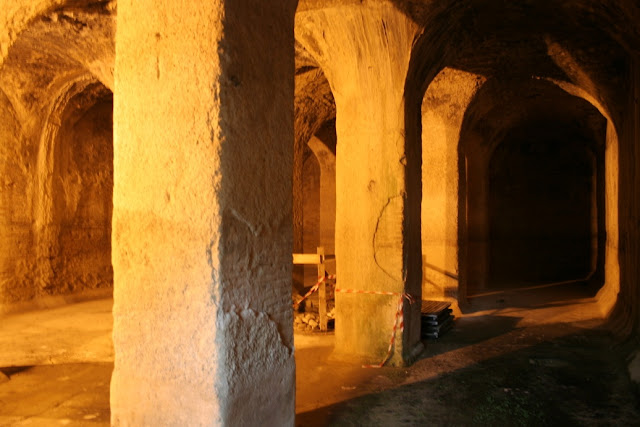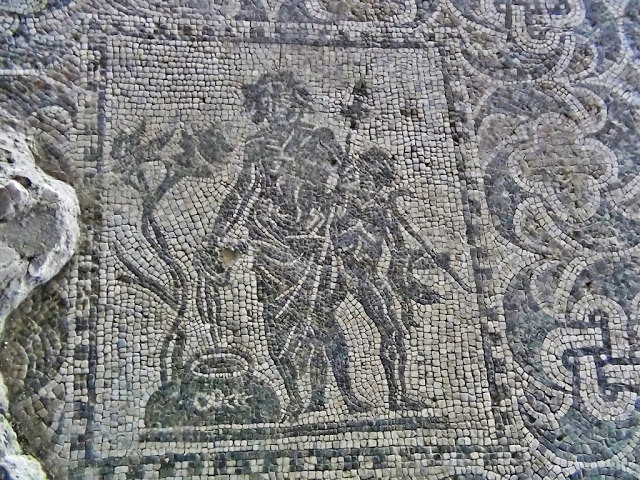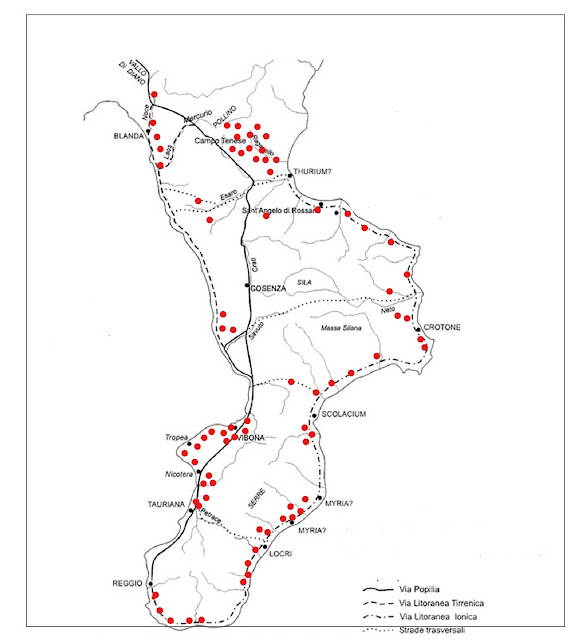Dear readers, we visit some of the most important Roman villas heretofore know in Calabria.
All over the calabrian territory are many remains of romans ville (map below).
dotted in red are the little remains of roman villas, mainly coastal.
In this post, show most rapresentative archaeological complexes in Calabria with rich mosaics, collocated in agricol landscape.
villa of NANIGLIO (Gioiosa Ionica)

STRUCTURE - Situated near the town of Gioiosa Ionica, it built towards the end of the I century b.C. and that reached its maximum splendor around III century a.C. to then suffer a slow and progressive abdonement.
In the first phase of its existence it was considered only a predia (farm), then transformed in a padronal villa (otium), in the ancient age (II-IIIcentury b.C.) became a luxurosius noble residence equipped with product structuries of the centre of the greatest agricultural.
Inside its area it had a residential neighborhood (for workes) and processig plant and storage, arrange on different levels, with exploitation a gentle slope, also provided structures related to the production.
The important point of the villa in "Hypogean cistern" composed in three aisles built by exaviting the embakment behind. The well-preserved environment bears witness to the emplementation of the "a rule of the arts" of the "pools" useful of collection of water and seem to have had a capacity of about 580 cubic metric of water (figure below).
hypogean cistern of Naniglio
Ubicated in a fertil territory
CONCLUSIONS - At the two ends this area, there are some rooms with polychrome mosaic floors with geometric motifs and painted plaster on the walls.
(foto by Katryn Tosini)

Quote di San FRANCESCO
The archaeological site late ancient age Quote di San Francesco (V century a.D.) is placed in municipaly of Portigliola (south of Locri), it's considered a rural dwelling but also building specializated under the productive profile (villae/praetorum).
The palatium was the fortified residence of powerful dominus, perhaps at the center of a largest landed estate, developed at a time in history when society was trasforming on taking on the apparence that would be characteristic of the medieval age.
Architecture - It was provided of a residential area, a thermal plant and nearby it we find an apsidal environment, all elements tipical of the roman architecture.
The residential part of the building probabily had to be located on the upper floor since in the lower part there is a lack of actual floors and in the walls (figure below), preserved in some places up to height of 4-5 m. there are traces of holes for intersing support beams on a second floor.
The ground floor was perhaps a place for defence since the rooms are provided with narrow single-light window.
thermal environments
(foto by ilreggino.it)
CONCLUSIONS - The life of the palatium of Quote San Franceso lasted until VII century a.C., when Arab raids plundered coastline.
NOTE - It was a fortified villa (praetoria/palatium) of a powerful landowner (Lord), built to protect itself from Barbarian, developed at a time in history whrn society was trasforming and taking on the appearance that would be characteristic middle age.
Roman VILLA OF CASIGNANA
The most important phase of the villa, whose original layout dates back to the I century a.D., is date of a major renovation in the IV century a.D.
It's a large complex of buildings of the I century a.C., covering about 12 hectares, around which a"statio" was developed that is a rest area for the officials of the imperial bureaucracy traveling from Reggio Calabria.
Is the most grea roman villa in Calabria, nowaday have been a brought ot light only the thermal baththe others environments around a cortyard, the floors the rooms are covered with rich and large mosaics.
ruins villa of Casignana
the great villa in front of the sea stood on the ancient road liking locri Epizefiri and Reghion (Reggio Calabria), nowaday the villa is cut by road. It was immersed in an agricultural territory and belonged to an influencial character.
termal environmets covered by mosaics
particolar mosaic inebriated Bacchus
other environment in opus sectile
other remains
Note - the opulence of Imperial villa was given by the production of wine.
ROMAN VILLA OF LARDERIA
HISTORY - Oenotrian, Greeks and Bruzian passed trought here, then belonged to a roman consul, it is one of the largest residential complecex in roman Calabria, born as early as the II century b.C. but what we see can be dated beetwen the I and the IV century a.C..
The villa consist of a rustic area, certainly intendet for slaves to process foodstuffs and store them, a resident that would completely abandoned at the and IV century a.C.
entrance to thermal environments III century a.C.
villa by drone
(foto by lacnews24.it)
mosaic fragment II century a.C.All the geometric patterns of mosaic on the floors
(by Carmelo Malacrino)
















.jpg)










Commenti
Posta un commento